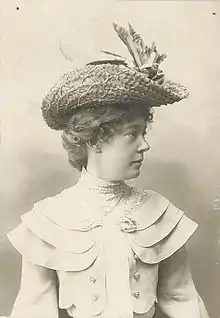Anna Bloch
Anna Kirstine Bloch (née Lindemann; 2 February 1868, in Horsens – 25 November 1953, in Copenhagen) was a Danish actress.[1][2]
Anna Kirstine Bloch | |
|---|---|
 Anna Bloch in 1904 | |
| Born | Anna Kirstine Lindemann 2 February 1868 |
| Died | 25 November 1953 (aged 85) |
| Nationality | Danish |
| Occupation | Actress |
Early life
Anna Lindemann's mother Bodil Margrethe Gylding (1838–1875) died when she was seven years old. Her father Johan Sørensen Lindemann (1825–1909) was a doctor in Horsens. She was taught privately, and consistently showed an enthusiasm for the theatre. Her father regarded acting as an unsuitable profession but eventually allowed her to join the Royal Danish Theatre after talking to its general director Edvard Fallesen.[1]
Career
At the Royal Theatre, Anna Lindemann was a student of Emil Poulsen and debuted in 1885 as Titania in William Shakespeare's A Midsummer Night's Dream. Between her first two roles she was taught by her husband to be, William Bloch. Together they wrote Miss Nelly in 1886, in which she later played the main role.[1] After their marriage in Summer 1887, she took her husband's surname.[3]
Anna Bloch's breakthrough came in 1888 as Trine in April Fools by Johan Ludvig Heiberg.[1] Literary historian Peter Hansen credits her with the "phenomenal run of 31 performances" of this modernised revival of the 1826 original.[4] Another early role was that of Hilde in Ibsen's The Lady from the Sea in 1889.[5]
Bloch was awarded the Ingenio et arti gold medal in 1910.[6][7] This was the 25th anniversary of her first role, and in a commentary for Politiken, Danish writer Emma Gad says that Bloch could make a normally insignificant role seem important to a play, as with the "brilliant and peculiar humour" of her portrayal of the "noble slut" (Adelstøs)[8] Eugenia[9] in Ludvig Holberg's Don Ranudo de Colibrados. For Gad, her most memorable performance was as the peasant girl Anjutha[9] in Tolstoy's The Power of Darkness, where she was "gripped by a fear so wild" that "her mysterious horror ... rippled down to the auditorium and ran like a shudder from row to row."[8]
Bloch left the Royal Theatre in 1918, although she returned for a season as guest actress and rejoined from 1922–25.[10] She found herself typecast as the young girl or woman, even playing the fourteen-year-old Hedevig in Ibsen's The Wild Duck in 1921 at the age of 53.[11] Only really at home in 19th century theatre and unable to find suitable roles in the new era which began after the First World War, she was overtaken by the naturalism in theatre arts which she had helped pioneer.[1] She did however tour the provinces, and appeared at the Betty Nansen Teatret.[10] She can be heard in a scene from Jens Christian Hostrup's Genboerne (The neighbours across the road) recorded in 1938.[12]
Danish literary critic Johannes Riis refers to Bloch as the Royal Theatre's "foremost naturalist actor" of the time.[13] Although she never acted in films, she was, according to Riis, a role model for Danish actress Clara Pontoppidan.[13]
She wrote a one-act comedy Saadan veksler (Such bills). The Royal Theatre presented this in 1923 with Bloch in the leading role and it was published in 1924. She also wrote two radio dramas, Epilog in 1934 and Veni, vidi, vici in 1935.[14][15]
Anna Bloch is buried in Vestre Cemetery, Copenhagen.[2]
Publications
References
- Andersen, Elin (2000). "Anna Bloch". Dansk Kvindebiografisk Leksikon [Danish Encyclopedia of Women's Biography] (in Danish). Rosinante. ISBN 87-7357-976-9.
- "Anna Kirstine Bloch". Kendtes Gravsted (in Danish). Archived from the original on 28 January 2020.
- Hansen 1896, p. 358.
- Hansen 1896, pp. 358–359. "... det fænomenale Tal af enogtredive Opførelser."
- "Det Kongelige Teater: The Lady from the Sea". All About Henrik Ibsen. National Library of Norway. Archived from the original on 23 June 2015. Includes a picture of Anna Bloch playing Hilde.
- "For videnskab og kunst medaljen Ingenio et arti" [For science and art: the Ingenio et Arti medal]. Litterære priser, medaljer, legater mv [Literary prizes, medals, scholarships, etc] (in Danish). Retrieved 6 September 2010. List of recipients. Self-published, but with references.
- "Denmark". World Orders and Medals (in Danish). ordersandmedals.net. Retrieved 6 September 2010. Provides details including pictures of obverse and reverse with ribbon of Ingenio et Arti medal awarded to Anna Bloch in 1910. Self-published. Navigation in English.
- Gad, Emma (4 September 1910). "1910 Anna Bloch, 4. sept. 1885–1910". Politiken (in Danish). Archived from the original on 21 June 2015.
... grebet af en Angst saa vild, saa rædselsfuld i en Mordnat for hende gaadefulde Gru, at den forplantede sig helt ned til Tilskuerpladsen og løb som en Gysen fra Bænk til Bænk.
- Behrens, C. (1915). "Bloch, Anna". Salmonsens konversationsleksikon (in Danish). III. Copenhagen: Schultz. p. 424.
- Neiiendam, Robert (1930). "Bloch, A. K.". Salmonsens konversationsleksikon (in Danish). XXVI. Copenhagen: Schultz. p. 137.
- Perrelli 2007, p. 20.
- Bloch, Anna (1984) [Performed 14 March 1938]. Genboerne – Scene mellem Malle og Rikke. Teaterliv 1923–1957 (LP) (in Danish). Danica. DLP 8050 1-2.
- Riis 2004, p. 6.
- Wiingaard, Jytte; Neiiendam, Robert (1979). "Anna Bloch". In Bech, Svend Cedergreen (ed.). Dansk Biografisk Leksikon (in Danish) (3rd ed.). Gyldendal.
- "Saadan veksler Anna Bloch : Interiør". WorldCat. Retrieved 19 July 2015.
Citations
- Hansen, Peter (1896) [1889]. Den danske skueplads; illustrerei theaterhistoire [The Danish Stage: illustrated theatre history]. 3. Copenhagen: Ernst Bojesen. pp. 357–359.CS1 maint: ref=harv (link)
- Perrelli, Franco (2007). "Protoregia o della complessità dei processi" (PDF). Prove di Drammaturgia (in Italian). XIII (2): 18–22. Archived from the original (PDF) on 2016-03-04. Retrieved 2015-06-07.CS1 maint: ref=harv (link)
- Riis, Johannes (Spring 2004). "Naturalist and Classical Styles in Early Sound Film Acting". Cinema Journal: 3–17. JSTOR 3661106.CS1 maint: ref=harv (link)
